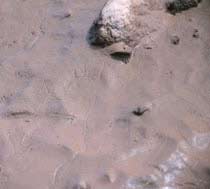Clay is formed by the action of wind and water on rocks over thousands of years.
This is the VOA Special English Development Report.

Clay is found almost everywhere in the world. It is formed by the action of wind and water on rocks over thousands of years. The rocks change in both chemical and physical ways. Chemically, elements like potassium and aluminum are added and taken away. Physically, the rocks break down into smaller and smaller pieces. After a long time, some of the rock changes to clay.
Clay is important because it is used around the world to make containers of all kinds. Potters add water to soften the clay. This makes it easier to form into shapes by hand or by machine. Then it is fired in an extremely hot stove. The result is a container with a hard surface that will last for many years.
In many countries, clay was formed from volcanoes. This kind of clay usually contains many minerals. So the fires to make containers from volcanic clay must be hotter than those used for non-volcanic clay. The fires may be as hot as 1400 degrees Celsius.
It is also important to dry the clay containers slowly. This means that the highest temperature should not be reached too fast.
You can add materials to clay to gain desired results. For example, you can add sand to prevent tiny breaks or lines from forming in the finished product. But you should not use sand from the coasts of oceans. Instead, you should use sand from rivers or from other areas of land that are not near the sea.
You can usually find good clay in low areas of islands or land, especially if volcanoes helped form the land. Clay often exists in fields covered with some water. The clay will be found about one meter below the ground. River banks often also have clay about one meter or less under the surface.
You can recognize clay because it is very shiny when it is wet. You can also perform a test. Take some of the material and add enough water to it to make it seem like you are making bread. Then press it in your hand until it is about the size of an egg. It is probably clay if it holds together instead of falling apart when you stop pressing.
And that's the VOA Special English Development Report, written by Gary Garriott. Guides to working with clay and other materials can be found on the EnterpriseWorks/VITA list of publications. These publications can be ordered for a charge. The list is available at enterpriseworks.org. Transcripts, MP3s and archives of our reports are at voaspecialenglish.com. I'm Chris Cruise.
potassium: a soft, highly reactive, silvery-white metallic element of the alkali group occurring in nature only in compounds 钾
Related stories:
From clay to art: exploring the world of ceramics
猫沙是谁发明的?
如何在流沙中“游泳”?
Subsoiling increases soybean and cotton production in clay soil
(Source: VOA 英语点津编辑)